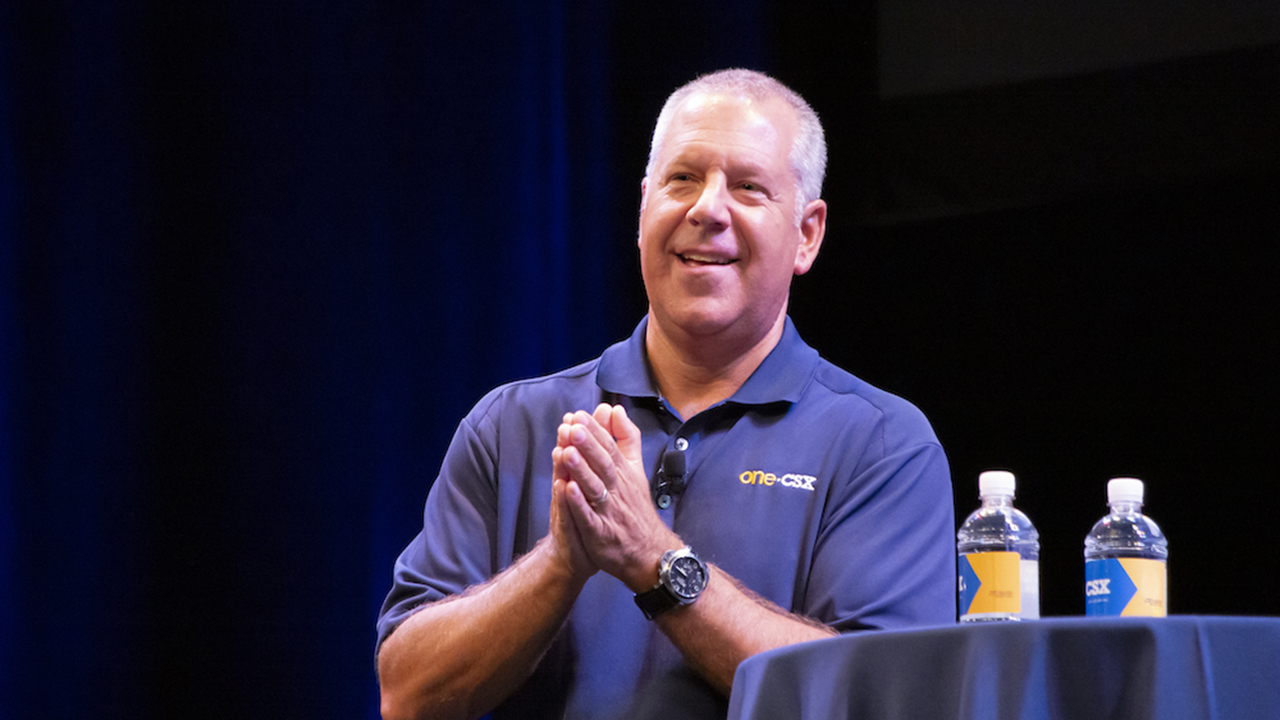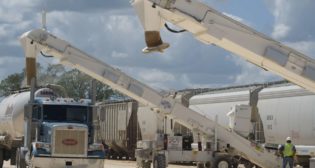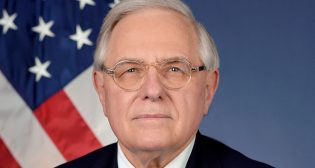
Report from NEARS: Joe Hinrichs with Jason Seidl
Written by Jim Blaze, Contributing Editor
CSX President and CEO Joe Hinrichs. CSX photo
There has been much talk from all sides of railroading this past decade about how to make freight railroading more relevant and increase rail’s market share vs. trucking. It comes down to making executive decisions that favor market growth vs. operating profit margins in the near 40% of revenues as the railroads’ corporate goal—a 60% operating ratio if you prefer that accounting term.
Was CSX’s Board willing to face such shifting challenges? Who’s going to lead such a new path? In Portland, Me., at the NEARS (Northeast Association of Rail Shippers) Fall Conference, in an easy speaking fashion, an “outsider” laid out his now-as-an-insider reasons for a shifting pattern, delivered in a soothing, believable, sort of “take it easy” manner.
Joe Hinrichs came out of a comfortable motor vehicle industry retirement. He didn’t need the money. He decided to come work for CSX only after he challenged the railroad search team as to how he saw their opportunity: one to be seized only by changing.
On Oct. 5, I listened as Hinrichs, in a fireside chat with TD Cowen Managing Director and Railway Age Wall Street Contributing Editor Jason Seidl, delivered in a relaxing manner his corporate new-direction message, and the logic for it, to the NEARS audience. He addressed those gathered as easy as if he was Glenn Frey of the Eagles capturing us with something like the lyrics of Take It Easy. But he did so as President and CEO of CSX.
Why does a rail economist like me find Hinrichs’ message so believable? I’m often a cranky contrarian, not so easily swayed by corporate-speak. Well, in few words, here’s why this time it’s more believable as a “change is under way” assertion.
Number one, much like I was way back in the 1970s, Hinrichs is a railroad “outsider.” I know first-hand the hurdles outsiders face. His career was partly as a railroad customer. Yet, in his interviews with CSX’s Board of Directors, he told them that he views his railroad hiring as requiring a new direction if CSX and its interchange partners were to become more market relevant. To reverse market share decline and find new sustainable freight customers as coal volumes continue to disappear, he alerted the CSX Board that they must become more customer-centric, that the heady decline in operating ratios they had been rewarded with over the past decade of OR focus must change. Elect him as their new sheriff, as a former buyer of transportation, but only if they as shareholder representatives understand and support how he sees the strategic path ahead.
As others like Loop Capital’s Rick Paterson have been saying, any new growth must somehow pass the shareholders’ patience test of withstanding financial return challenges (lower returns) for perhaps more than just 18 to 36 months.
Hinrichs’ plan reiterated for the NEARS attendees was delivered with clear business logic, controlled passion, sound business principles spelled out—a message perhaps more trustworthy when delivered by a former rail service buyer.
Here are a few telling points:
First, to me, he clearly stated that, as a business, CSX is a service provider. That’s important to me as an insider economist, because I was indoctrinated into the position that a railroad was a product first. Railroads were a huge geographic asset base requiring a return on those difficult-to-reproduce physical assets. Instead, Hinrichs’ message is a reminder that we railroaders physically provide a service. We compete for opportunity to take an outsider’s product from a location of low utility value to a location of much higher productive value. That’s a service. Railroads must change that corporate mindset and understand why our internal productivity-management style is causing customers to walk away, and why attracting new or replacement customers is increasingly difficult.
Hinrichs got my attention. His core targets in mentally reshaping CSX are not limited to management. His mission is to re-energize the service capability of CSX’s entire labor force. He wants to use the skills of his vast labor pool to improve the quality of customer contact and the resulting improved customer trust as a competitive advantage, changing the friction-based relationships I witnessed during my decades-long rail career.
The rationale Hinrichs laid out made perfect sense. He specified how his work force was to be an essential “weaponized” advantage rather than a cultural internal friction point—a handicap converted to a critical mass advantage. That subtitle corporate DNA “surgical” modification could intellectually be the most critical task ahead. Such a shift could mark the long-hoped-for next freight rail renaissance moment.
Hinrichs is on a mission to change how investors in CSX and the management together with the entire labor force view their role as service providers. He realizes that such a shift is going to take some time. A century or more of distrust (friction) between CSX’s historical companies (including parts of Conrail) and its skilled unionized workers can’t be reconstituted overnight. There will be bumps in the corporate quarterly accounting reporting as the company is re-organized and reshaped as to its managed customer-centric daily approach.
Too often, customers have experienced a “take it or leave it” business attitude. Now, will they want to take a “show me” attitude before they start to sing along with CSX’s new service lyrics? Hinrichs sees his role as “more like a coach.” He was initially surprised at “the amount of angst and animosity” between CSX’s customer base and the railroad company itself. He saw this as a hurdle that must be addressed by refocusing the railroad as a service business.
Recognizing service as CSX’s core mission, Hinrichs’ business approach is to re-engage with CSX employees at all levels, because it’s the employees that directly engage with customers as a service provider. That seemed right away to be his first principle to improve CSX. We need to change the cultural friction between the executive team and the workers. Customers don’t buy transportation willingly. They buy rail only if they really need us more than needing trucks. How can CSX be a priority choice of customers with better choices? That’s how he sees CSX’s new teaming mission.
Hinrichs also acknowledges that STB regulators are now more active in their oversight because rail freight service delivery has deteriorated. Their oversight is to be expected. We as railroaders need to respond because this is a legitimate shortcoming of us as service providers. He seems comfortable recognizing that CSX can respond without the legal force of regulatory mandates. That choice is ours to make as railroad executives, rather than force the regulator’s hand.
We must improve worker relationships to grow as a service business, Hinrichs said. I almost spilled my coffee when I heard that blunt statement, because I did not often here such a direct assertion during my time on railroad executive floors.
During Hinrichs’ decades of interaction as an outsider (a service buyer), he saw that the older, change-resistant freight rail company attitude has been improving. Today’s CSX (and competing rail companies) realize that they face increasingly tough truck competition. When he arrived at CSX, his team was already concerned with how they’d have to improve with or without him as their new leader. He recognizes this as critically important to his coaching task.
For me, my usual Blaze skepticism was soothed as if I was calmed by Hinrichs’ easy delivery style. He had me smiling when we briefly shook hands as he left the Portland auditorium. I don’t smile easily.
Jason Siedl’s takeaways are in line with mine:
“We kicked off the Fall NEARS conference with a fireside chat with CSX CEO Joe Hinrichs and were encouraged to hear his strategic vision for the Class I centered on long-term volume growth. Overall, most of the attendees viewed his commentary as a proverbial breath of fresh air, which should not be that surprising considering he was once a rail customer. CSX has lately been an industry leader when it comes to service quality, but the railroad continues to strive for improvements with a focus on optimizing the network for growth. CSX emphasized that trip plan compliance in the 90s is its new baseline, with the aim of driving this metric closer to truck levels (in the high 90s) to drive conversions. Hinrichs pointed out that CSX sees ~10,000 cars a day that do not get to their destination, out of ~107,00 cars/day.
“Hinrichs noted that manpower availability has been the largest difficulty in achieving consistent, predictable service. Recent overtures to unions are part of a broader bid to preserve a labor pool positioned to handle more volumes. As we have stated previously, the rollout of attractive salaries and benefits are labor-intensive and demanding, pressuring near-term margins though encouraging (and arguably necessary) for the industry, long-term. Hinrichs has focused extensively on creating a better culture at CSX, and early indications from contacts have been that this is being viewed positively by employees.
“Both CSX and Norfolk Southern alluded to partnership with short lines in pursuit of their growth strategies and value proposition to shippers. NS emphasized the importance of first-mile/last-mile moves and noted that 40% of its industrial products business touches a short line with the view of commanding the entirety of a shipper’s supply chain. Looking into 2024, CSX plans to improve service to the point that the railroad can also lean into growth for new short line projects.”

Independent railway economist and Railway Age Contributing Editor Jim Blaze has been in the railroad industry for close to 50 years. Trained in logistics, he served seven years with the Illinois DOT as a Chicago long-range freight planner and almost two years with the USRA technical staff in Washington, D.C. Jim then spent 21 years with Conrail in cross-functional strategic roles from branch line economics to mergers, IT, logistics, and corporate change. He followed this with 20 years of international consulting at rail engineering firm Zeta-Tech Associated. Jim is a Magna Cum Laude Graduate of St Anselm’s College with a master’s degree from the University of Chicago. Married with six children, he lives outside of Philadelphia. “This column reflects my continued passion for the future of railroading as a competitive industry,” says Jim. “Only by occasionally challenging our institutions can we probe for better quality and performance. My opinions are my own, independent of Railway Age. As always, contrary business opinions are welcome.”
![“This record growth [in fiscal year 2024’s third quarter] is a direct result of our innovative logistic solutions during supply chain disruptions as shippers focus on diversifying their trade lanes,” Port NOLA President and CEO and New Orleans Public Belt (NOPB) CEO Brandy D. Christian said during a May 2 announcement (Port NOLA Photograph)](https://www.railwayage.com/wp-content/uploads/2024/05/portnola-315x168.png)


